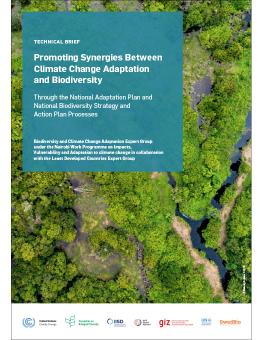
Promoting Synergies Between Climate Change Adaptation and Biodiversity Through the National Adaptation Plan and National Biodiversity Strategy and Action Plan Processes
With practical entry points and country case studies, this technical brief reviews the interconnections between biodiversity and climate change adaptation and explores the potential to foster synergies between the processes to formulate and implement National Adaptation Plans and National Biodiversity Strategy and Action Plans. .
-
Climate change impacts ecosystems and is among the main drivers of biodiversity loss. In turn, protecting and valuing biodiversity can help people and communities adapt to climate change by increasing ecosystem resilience.
-
Strengthening the synergies between the NAP and NBSAP processes increases integration and coherence, reduces duplication, and makes the best use of limited resources for planning, implementation, monitoring, and finance.
-
Eswatini, Fiji, Peru, and Rwanda emphasized linkage in their respective national biodiversity and climate strategies, which helped mainstream an integrated approach to system thinking and enhancing ecosystem and social resilience to climate change.
Countries around the world are grappling with the far-reaching and sometimes irreversible impacts of climate change and biodiversity loss. Exploring and building synergies between climate and biodiversity strategies at the domestic level will be pivotal for the achievement of the United Nations Framework Convention on Climate Change (UNFCCC), the Paris Agreement, and the Convention on Biological Diversity (CBD), as well as the Sustainable Development Goals.
A good strategy for realizing these synergies is the integrated implementation of both the UNFCCC and the CBD parties’ commitments at the national level. This requires domestic policy coherence and joint action across the design, financing, implementation, and review of (and reporting on) National Adaptation Plans (NAPs) and National Biodiversity Strategy and Action Plans (NBSAPs). Promoting synergies between the two processes provides a pivotal opportunity for national policy-makers to consider how they can best coordinate their efforts so that climate adaptation and biodiversity actions become mutually reinforcing.
This technical brief, which has been published as a supplement to the NAP technical guidelines, reviews the interconnections between biodiversity and climate change adaptation and explores the potential to foster synergies between the processes to formulate and implement NAPs and NBSAPs. This will be underpinned by highlighting practical entry points and lessons learned from case study examples on effective coordination and joint implementation of climate change adaptation and biodiversity actions at the national level. It targets country-level CBD and UNFCCC focal points and technical staff of ministries who are engaged in the planning and implementation of NAPs and NBSAPs.
Participating experts
You might also be interested in
Synergies Between Biodiversity and Climate Policy Frameworks – A Series of Thematic Papers
These thematic papers have everything policy-makers need to pursue more synergistic responses to address the co-existing challenge of climate change and biodiversity loss.
Addressing Biodiversity Loss and Climate Change: Three ways adaptation planning can help
Biodiversity loss and climate change must be addressed urgently and ambitiously – until now, these agendas have remained separate, but neither will be resolved unless both are tackled together.
Border Carbon Adjustments: Trinidad and Tobago country report
This report consolidates, analyzes, and presents views and perspectives of stakeholders from Trinidad and Tobago on border carbon adjustment (BCA) schemes to contribute to the global debate on BCA good practices.
How Can We Work With Nature to Tackle Drought and Desertification?
Drought is one of the most devastating and pervasive challenges exacerbated by climate change. However, we can work to reduce its effects through nature-based solutions for land restoration and climate-smart agriculture.
